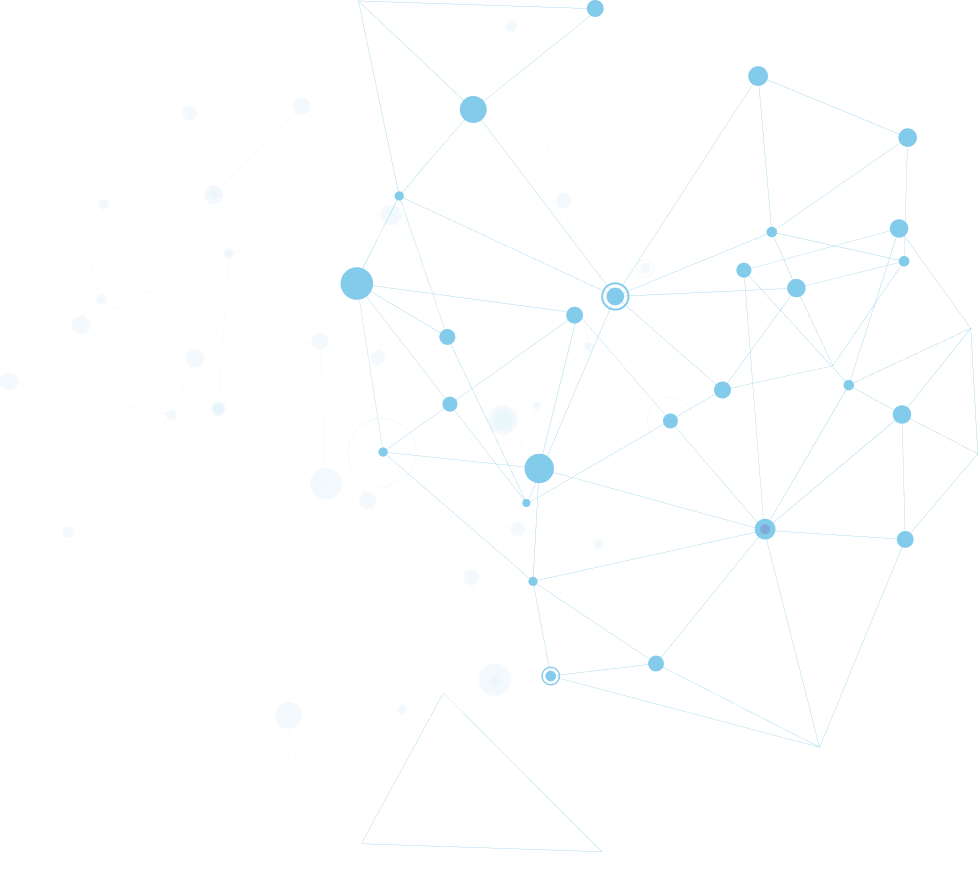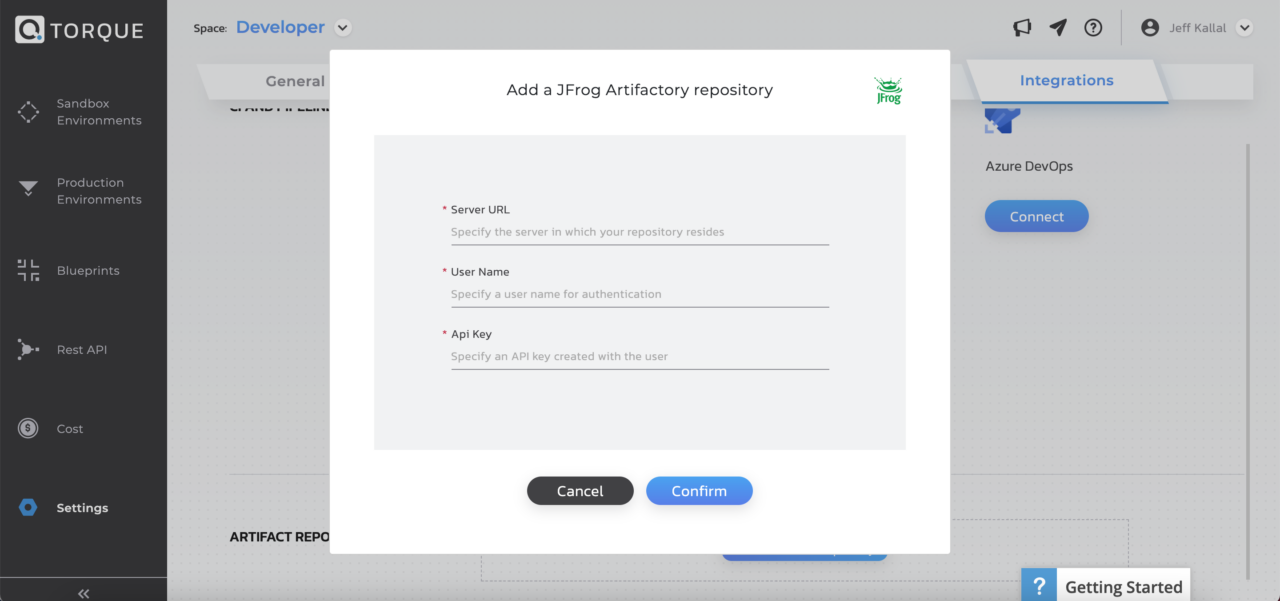

JFrog
An Integrated Solution
JFrog has partnered with Quali to provide a “single pane of glass” experience to address the challenges and needs of these organizations and enable true DevOps collaboration across these different teams. Quali’s “Environment as a Service” platform gives development teams on-demand, self-service access to blueprints that model both cloud resources and applications, making it easy to automatically deploy environments on the cloud (VMs or containers).
With JFrog Artifactory integration into Quali’s Cloudshell and Torque platform, developers can retrieve and install the latest artifacts on the target infrastructure, such as AWS, Azure, or Kubernetes.
Quali enables users to connect JFrog Artifactory inside CloudShell and Torque helping them to retrieve and install artifacts that are in use in the target infrastructure, such as AWS, Azure, or Kubernetes. Jfrog coins the motto of “the world’s first universal repository.”
JFrog Artifactory is the center of the JFrog Platform functioning as the single source of truth for all artifact packages, container images and Helm charts as code moves through the CI/CD pipeline.
Quali and JFrog create:
- Repeatable Test Workflow Automation and Distribution via CDN: With the Jfrog’s single source of truth approach and Quali’s connection into your CI/CD pipeline, synchronizing repository artifacts across distributed development teams becomes scalable.
- Self-service, federated artifacts: Quali Torque integrates with Artifactory and your existing CI/CD pipeline to automate dev/test environments to speed up release times providing a consistent workflow and overcome complexity of working with different binaries.
Learn more at JFrog.com
To allow for seamless use of artifacts in your pipeline, Torque integrates with common artifact repository providers.
When launching sandboxes, Torque pulls the artifacts from the repository into the sandbox’s compute instances, making artifacts available for application’s deployment scripts.
The integration creates an efficient way for developers to retrieve and install artifacts on any virtual machine deployments in the Torque sandbox.
The execution servers communicate to the target VM server using SSH and copies the bits over. Finally, the application is installed on the target server.
Automated Test Workflow
- Integrating Artifactory into CloudShell provides a fully automated, end-to-end workflow from the creation of a new build artifact to deploying the corresponding application on a newly created VM in a CloudShell sandbox.
Self-Service for DevOps Teams
- Integrated platform gives development teams on-demand, self-service access to blueprints making it easy to automate the deployment of application and infrastructure environments on the cloud.
Eliminate Deployment Errors
- Make database auditing easy and eliminate manual tracking of deployments and errors.
Liquid Software flows through a pipe, and that plumbing needs to be properly sealed. Releasing your application with agility requires your environment—infrastructure, applications, and data—to be ready at every point in the pipeline, from development to test to production.
The different teams in that process face their own challenges around environments:
- The developer wants the environment to be ready, available, and configured as needed, static or dynamic.
- The DevOps engineer wants to make sure the latest application version is automatically released as fast as possible.
- The IT manager needs to control the allocation of resources, especially when it comes to public cloud expenses, and needs to have visibility of what infrastructure is being consumed by the entire organization for the end-to-end release process.
Since these three teams have conflicting priorities, they end up working in silos. This slows down automation efforts and keeps DevOps initiatives from spreading beyond a small group of individuals.
How Does it Work?
It only takes four simple steps to deploy even the most complex application environment “as a service.”
Step 1: Configure Accounts
The first step is to configure your Artifactory server and other cloud accounts. This is typically performed by the IT/DevOps admin.
Step 2: Create and Launch a Blueprint
The next step is to set up a simple blueprint in YAML format and specify the default artifacts, security parameters and application components (e.g., microservices). Example YAML files can be found on our community.

Once this blueprint is saved and version controlled in GitHub or Bitbucket, it is automatically synced to your Quali Torque account and ready to be published to a team of developers, testers, or pipeline DevOps tools.

At that stage, a developer can just select a blueprint and launch a new environment, also available through a REST API. Enter a few parameters, to change the default values of the artifact for instance, and click Launch Sandbox.

At that point, the Torque orchestration engine kicks in behind the scenes and dynamically creates and configures the complete environment. Before the release to production, each sandbox environment is considered ephemeral. That means the environment only lives for a specific duration, and is automatically cleaned up once it expires or is no longer needed. This enables IT to ensure proper and automatic disposal of these environments and control infrastructure costs.
Step 3: Build and Test
Once the sandbox is up and running, it is available for consumption by the test process, including readily available shortcuts to application and infrastructure components, as well as troubleshooting tools.

Step 4: Release to Production
Finally, once the test phases are complete, it is time to release the application to production. To do so, blue/green deployment provides a gradual introduction of the new version to a percentage of users, giving additional time to get feedback and take corrective action if needed. This is a very simple task to perform with Torque, either through the web UI or through API.

From Build to Release to Production
Integrating Artifactory into Torque provides a fully automated, end-to-end workflow from the creation of a new build artifact to deploying the corresponding application on a newly created VM in a Torque environment. The rapid transition from an on-prem build to a cloud installation provides the agility and increased velocity that is core to the DevOps process and ensures that applications are deployed into production-like environments.
Combining the highly scalable power of Artifactory with the orchestration and automation of Torque enables deployment of version-controlled artifacts along with their associated infrastructure. Working together, they help bring speed and fidelity across the CI/CD pipeline workflow, enabling enterprises to scale DevOps to their entire organization.
Read about why JFrog partners with Quali to enable a smooth transition of services to the cloud.
To learn more about Quali’s Artifactory integration, watch this short video.